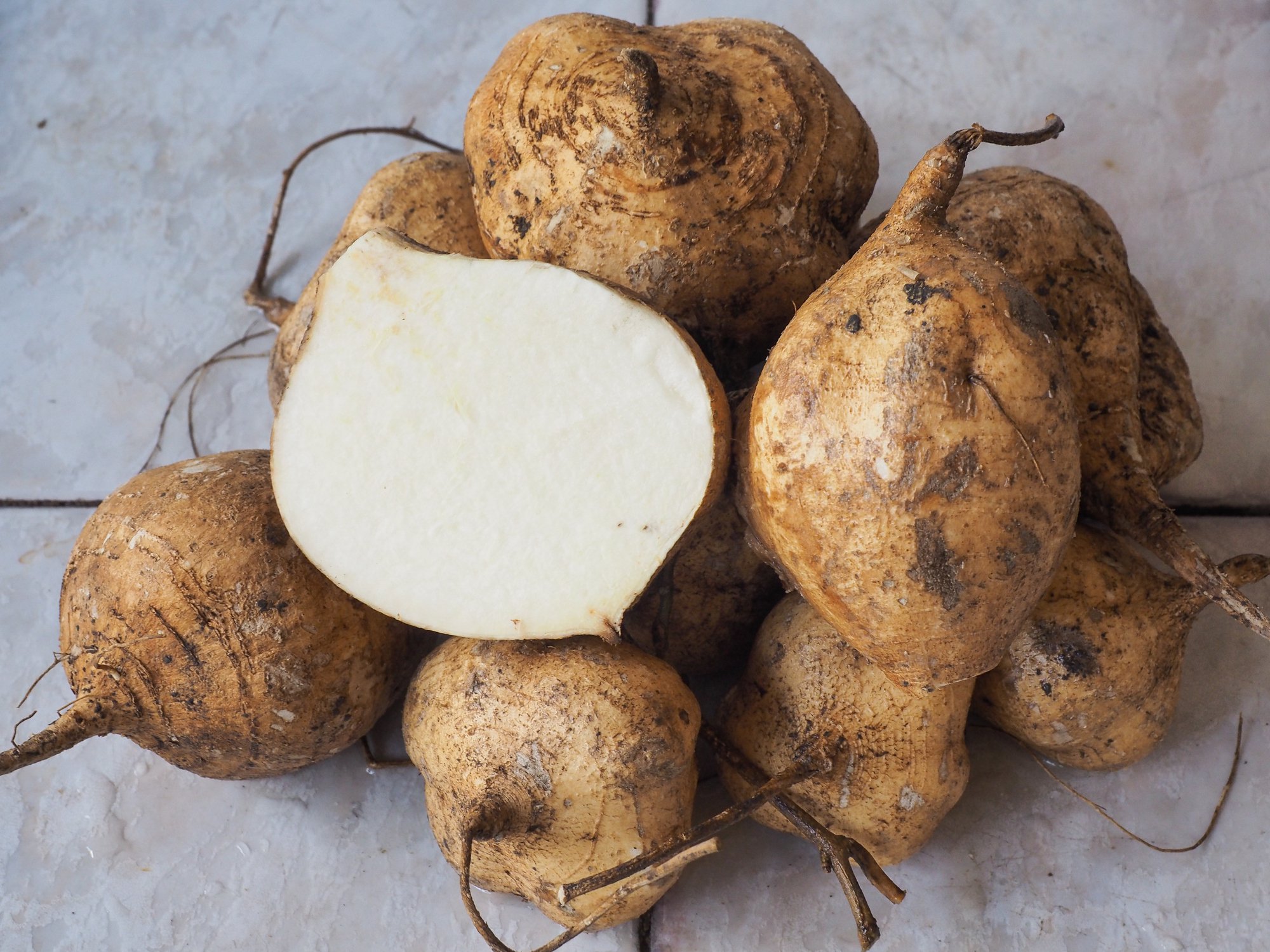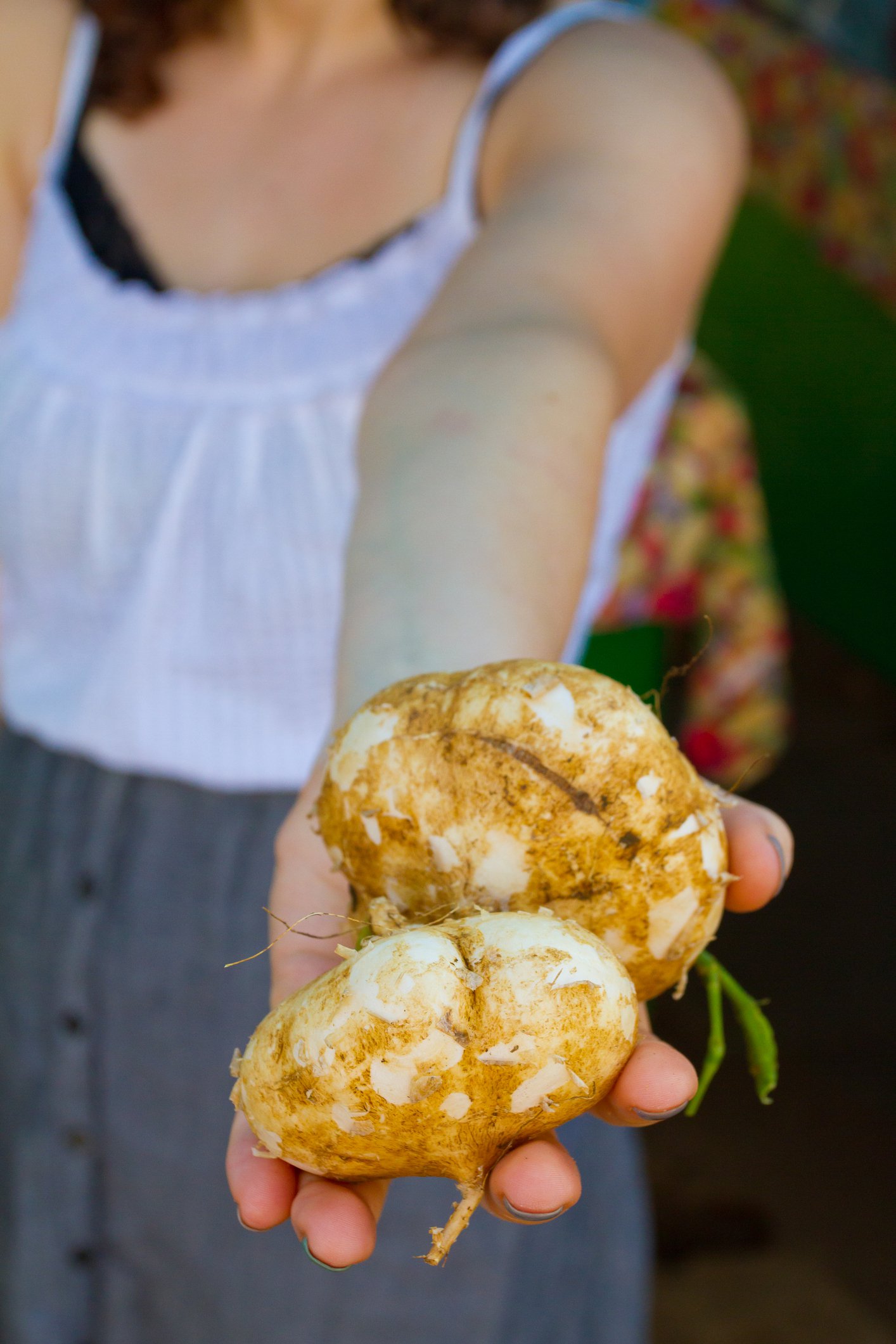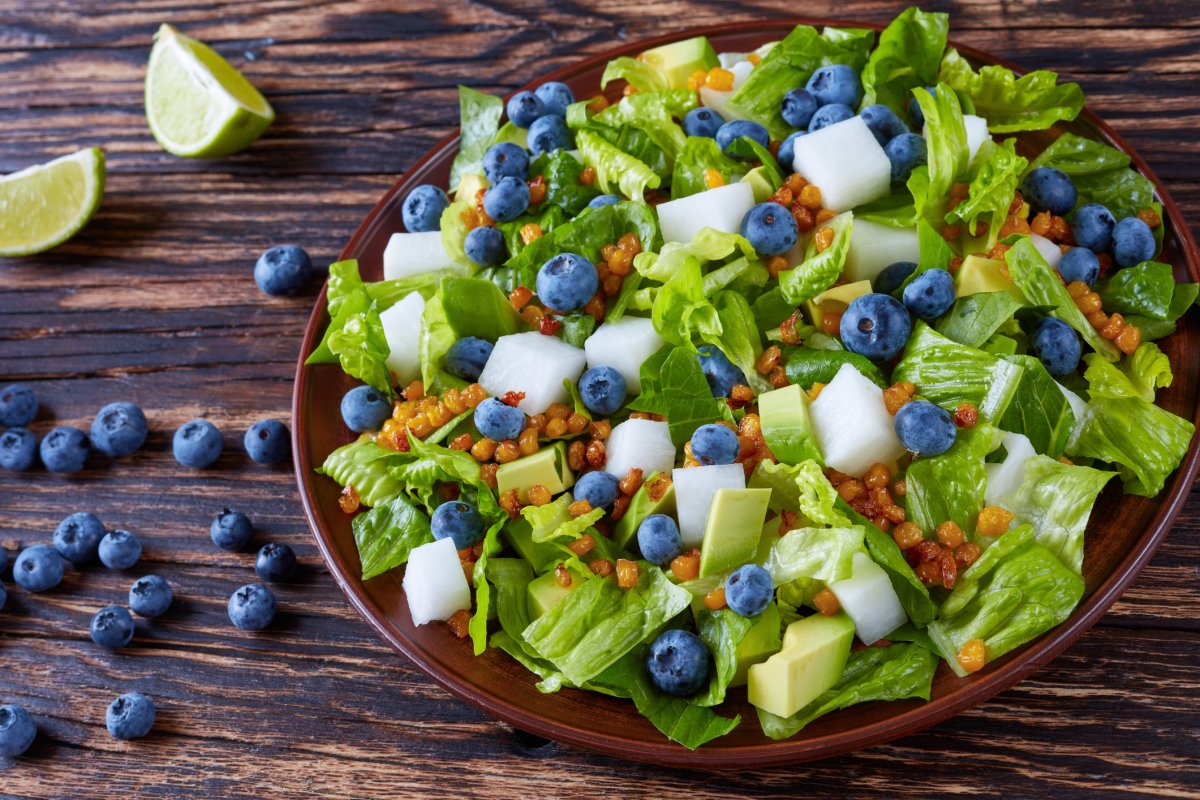Jicama — pronounced HEE-kah-ma — is a root vegetable that might be hiding in plain sight in your supermarket produce aisle. Though unremarkable in its appearance, this odd-looking love child of a giant water chestnut and a potato offers a unique taste, a stellar nutritional profile, and several health benefits that make it worth checking out.
What Is Jicama?
Is jicama a fruit? A vegetable? A root? Something else altogether?
The name “jicama” actually refers to the round, gold, tuberous root of the bean-producing Pachyrhizus erosus vine, which can grow to be up to 20 feet long. It’s a relative of the bean family and is sometimes called Mexican yam bean, Sweet turnip, Mexican turnip, and Chinese potato.
One large jicama can weigh up to fifty pounds! On the outside, jicama is rough and papery, sort of like a turnip or rutabaga. Inside, you’ll find a juicy, crunchy, white starch similar in texture to a crisp pear or water chestnut.
Native to Mexico, jicama is also grown abundantly in parts of Asia and the Philippines where it benefits from a long growing season without frost. It can also be grown in USDA zones 7 through 10 in the United States.
Jicama Nutrition Facts
Jicama’s rich in complex carbohydrates and an excellent source of fiber. In one cup, you’ll get almost seven grams of fiber — nearly ¼ of the official recommended minimum intake for the day. So even though jicama has carbs, the amount of fiber it has slows down its impact on your blood sugar.
Jicama’s a solid source of other important vitamins and minerals, such as folate, magnesium, potassium, manganese, and small amounts of omega-3 and -6 unsaturated fatty acids. And it contains appreciable amounts of vitamins B1, B2, B5, B6, and E, as well as zinc, copper, calcium, and phosphorus.
The Mexican turnip’s also a great source of vitamin C, an essential water-soluble vitamin and potent antioxidant. One cup provides 44% of your daily minimum vitamin C requirement.
5 Health Benefits of Jicama
Like many plants, the jicama vegetable contains a large array of nutrients, but its special kind of fiber is particularly valuable.
1. Good for Digestion:
If you want a healthy gut, you need to consume enough dietary fiber (a feat that roughly 97% of Americans don’t accomplish). Eating enough fiber adds bulk to your stool, keeps things moving regularly through your intestines, and reduces your risk of various digestive diseases and disorders.
Jicama is an all-star source of fiber, which is good news for health lovers. And it’s a rich source of a particular type of insoluble fiber called inulin. Inulin is a prebiotic, meaning it feeds your probiotics — the good bacteria in your gut — so they can do their job and keep you healthy.
2. Has Cancer-Fighting Properties:
The inulin fiber in jicama isn’t just good for your gut. It can also help reduce your risk of certain cancers, especially colon cancer. Jicama also contains several antioxidants, including vitamins C, E, and selenium, that prevent oxidative damage to your cells and inhibit cancer growth.
3. May Help Treat and Reverse Diabetes:
Jicama also has unique properties that can be good for diabetics and blood glucose management. A 2016 study in mice found that six weeks of jicama extract administration significantly reduced blood sugar and Hgb A1c levels, and increased insulin sensitivity.
The low glycemic load of jicama also makes it a good option for people with diabetes, as it won’t spike blood sugar. And its fiber content aids in weight loss, primarily by increasing satiety (a fancy word that means that it makes you feel full). This is another way it contributes to fighting diabetes.
4. Improves Heart Health:
By helping to lower blood sugar spikes and improve insulin sensitivity, jicama also reduces your risk for cardiovascular disease. The fiber in jicama can help lower inflammation, reduce LDL cholesterol levels, and lower blood pressure. And its high level of nitrate can improve blood flow and circulation.
There is also evidence that jicama can lower your risk of blood clots. In a 2016 study, healthy adults who consumed 500 ml of jicama juice reduced their risk of developing blood clots, compared to a control group who drank guava juice and water.
5. Benefits Your Bones:
The inulin in jicama can support bone health by retaining minerals in your bones, improving calcium absorption, and reducing bone loss.
Jicama nutrition also contains minerals that are important to healthy bones, such as manganese, calcium, potassium, phosphorus, and magnesium.
How to Eat Jicama
Jicama has a starchy, sweet, nutty flavor that complements the flavors of many foods. And it works well in salads, savory dishes, and even some sweet ones.
Jicama is sold by street vendors in Latin America, where people often enjoy it raw. Sometimes they’ll sprinkle it with a bit of lemon juice and cayenne pepper.
Note: There’s one big warning with knowing how to eat jicama. Don’t consume the leaves, seeds, or flowers of the plant. These parts — and actually most of the jicama plant besides the root itself — are toxic and should not be consumed. You won’t find anything but the root sold at most mainstream grocery stores, but keep this in mind if you ever grow or harvest it.
So, what do you do with the jicama root? Many people enjoy it raw, cut into sticks, used in slaws, and on salads. You’ll want to remove the skin first, not only because it’s thick and fibrous, but also because it contains a toxin that protects it from pests while it grows underground.
This video shows you how to tell if jicama is ripe and how to prepare it raw.
You can also cook jicama and use it in stir-fries, soups, mashed like potatoes, or baked into crispy chips. Some people even recommend slicing it thinly and using it as a soft tortilla or handheld taco shell.
As for storage, jicama is a little higher maintenance than your average tuber. It doesn’t tolerate temperatures below 50 degrees Fahrenheit. This means that the refrigerator isn’t ideal, although I find that it lasts for 1-2 weeks in a fridge if left unpeeled. If you’re aiming for optimal storage, keep jicama in a basement or garage, or another place in your home that runs between 53 and 60 degrees Fahrenheit. Here, it can stay fresh for up to two months.
Of course, the best way to store jicama is not to. Bring it home and start using it right away!
Where to Find Jicama
Although jicama may not carry the popularity of say, bananas and apples, it’s becoming more widely consumed. It’s typically in season from fall to spring in each hemisphere, making it available pretty much year-round.
Most grocery stores carry jicama in their produce section, usually near the other roots and tuber vegetables. If you can’t find it there, check natural food stores, farmers markets, or Mexican grocery stores. If you still don’t find it, you may be able to put in a special request with a produce manager. You may also be able to find pre-cut and packaged jicama sticks, as well as snack foods like jicama chips or tortillas.
And here’s an important hint: When choosing jicama, don’t pick the largest one in the pile. As jicama gets bigger, it actually loses its crispness and flavor. The texture can also become a bit tougher, so pick one on the smaller side.
Healthy Jicama Recipes To Try
Jicama can be eaten in many tasty ways, and often in recipes you might be used to making with other ingredients. Here are some simple and healthy recipes that use this vegetable.
Black Bean Tacos with Spiralized Jicama and Avocado Mash by Inspiralized — Spiralized jicama adds a fun texture to this fresh dish. It’s paired with healthy fats from an avocado mash and gets extra fiber and protein from black beans.
Mango, Avocado, and Jicama Salad with Lime Dressing by Edible Perspective — With fewer than ten ingredients, this easy dish comes together to create a nutritious and flavorful plate highlighting jicama and dark leafy greens.
Baked Jicama Chips by One Green Planet — This is a light and simple recipe that involves slivering, flavoring, and baking fresh jicama. It makes a healthy snack or a great side dish for any meal.
Slivered Vegetable and Tofu Stir-Fry by MyRecipes — This stir-fry is a delicious combination of nutrient-packed veggies and baked tofu. You can make it oil-free by sauteing the vegetables in water or vegetable broth.
Baked Jicama Fries by Eating Bird Food — An intriguing alternative to traditional french fries, this recipe uses sliced jicama with a flavorful seasoning, baked in the oven.
Here’s to Jicama
If you’re looking for a new, healthy vegetable to add to your diet, then jicama could be the perfect option. Jicama is good for you. And it’s full of valuable fiber, plus plenty of antioxidants, vitamins, and minerals that are beneficial to your health. And, it’s versatile, refreshing, and delicious. Prepared the right way, it might even become a new household favorite.
Tell us in the comments:
- Have you tried jicama?
- Do you have a favorite way to eat jicama?
- What other root vegetables do you enjoy?
Featured Image: iStock.com/eedology






